How To Make Sea Salt
Oct 22, 2011, Updated Jun 18, 2014
Linda Miller Nicholson writes the aptly-named blog Salty Seattle, and is known as much for her sassy stilettos as her sous-vide. She’s a conscious omnivore, food-sorceress, and slow-food salt-maker. She lives in Seattle, Washington, with her husband Jonas and their toddler Bentley Danger. (Yes, that’s really his name). You can catch up with her, or at least try to, on Twitter.
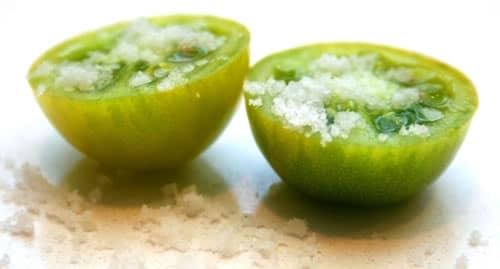
To know Andrew is to love him, there is no way around that fact. Consequently, when he asks you to do something, the only acceptable response is an enthusiastic YES! I have a fair amount of experience in making salt, so Andrew thought it would be a great thing to share with the many participants in the #unprocessed challenge.
Andrew’s totally going to make all of us into one big, happy Little House on the Prairie family by the end of the month, so we might as well embrace it. After you tackle salt, be sure to ditch your baking soda leavening agent in favor of ground deer antler, ok? But for now, something simple. Elemental. Salt.
Back in the days when my husband and I were blissful DINK’s (double income no kids), I’d collect shoes from every place we traveled. Whether we were in Tijuana, Mauritius, or the far-reaches of Eastern Romania, I’d shove my feet in the nearest goat hair confection — the weirder the better.
Fast-forward to my present life of polyandry: I’m married to my husband and a height-of-the-market mortgage, and I make do on the diminutive salary of a freelance writer. And then there’s my toddler, Bentley Danger, who has a shoe habit that rivals mommy’s because his feet grow like bamboo on steroids. Sadly, stiletto-hoarding no longer pencils out.
During those well-shod travels, I saw a lot of seas. In every port, I found a different salt on the shelves of the local grocer. In Hawaii there is the eponymous red alaea- course ground and tasting of clay. In Sicily there is sea salt collected in pans from corraline Trapani.
Soon, I had amassed a stockpile of more than 30 salts from around the world; the only rule was I had to have visited the source. Then the salt-craze hit the US and stores cropped up like The Meadow in Portland, OR, which sells hundreds of far-flung salts. Selecting salt at the market has never been more difficult. During my last excursion to Whole Foods I counted 15+. While the choice may be hard, a little bit of finishing salt goes a long way, and different salts complement different foods. Don’t believe me? Host a salt-tasting soiree and see for yourself.
When my global collection became less precious because I could find the same stuff around the corner, I began harvesting small amounts of seawater during our travels. If we rented a condo, I’d use a combination of sunshine and stovetop evaporation to make salt from the nearest shore. I learned that salt from Puerta Vallarta tastes like jet ski fuel, whereas salt from Victoria, BC is delicate, like the lips of a mermaid.
Soon, I had a major case of the self-harvesting bug. Through a combination of trial-and-error and studying pollution patterns, I discovered my personal collection spot not far from Seattle in the vicinity of Deception Pass, Washington. One of the challenges associated with self-harvesting salt is that you need a lot of water in order to make just a few cups. The rule of thumb is about five gallons of seawater yields four cups of salt, but elements such as salinity of the water upon collection — has it rained recently? — can skew the ratio.
Always gather from an area that is clean, legal, and safe. High winds, blustery rain storms, and electric fences on naval bases are all red flags I’ve ignored. Learn from my mistakes! Calm, rain-free days on desolate shores make for easy seawater-gathering. Rain is not only uncomfortable, but it dilutes the water, amounting to less salt.
I gather water with medium-sized, rectangular, lidded coolers. Round drink coolers are buoyant and difficult to shove down in the surf, and 5-gallon water jugs don’t have a big enough opening to gather seawater effectively. To avoid silt, it’s a good idea to walk out into the surf as far as your constitution will allow. Better yet, collect by boat.
After you’ve schlepped your water home, rack it, just like wine, for a few days. That means leave the cooler untouched in a cool place, so that all the sediment and salt particles sink to the bottom. Next, siphon the clean water into a large cauldron. I use a canning pot. Do not siphon the bottom inch or so, as that contains impure sediment. Place the cauldron over low heat on the stovetop. Ideally the water should never go over 170°F, and whatever you do, DON’T BOIL IT — that will ruin the crystal structure.
If you’re processing five-gallon batches, it may take a day or two to evaporate, but keep an eye on it. Once the water level drops to a few inches, crystals will start to form. At this point, I like to remove the pot from heat and carefully (so as not to compromise the crystal structure) pour the water into a wide, shallow pan. If it’s sunny enough, I will do the final evaporation in my light-filled window box. If it’s midwinter, I give up on the notion of sun-dried salt and evaporate it in the oven, stirring gently every once in a while, with the oven at the lowest setting. This method produces better crystals because it provides more even evaporation than the stovetop. I resist over-evaporation because it weakens the flavor. Instead, I let the last of the water drip out of the salt by placing it in a tamis (ideally) or shallow sieve for a few days.
Salt-making is an addictive adventure, but the reward is great. I always make more than I think I’ll need because news of a fresh harvest travels fast. Head seaward and gather some water before it’s so cold you freeze your thighs off. You won’t regret it.
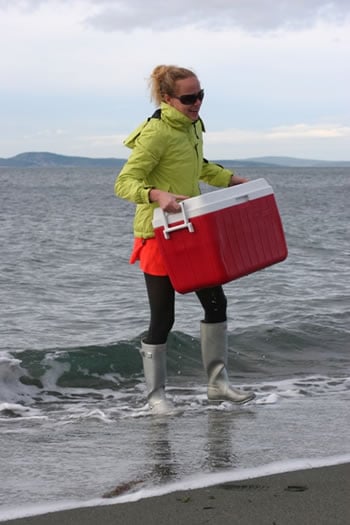

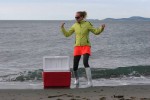

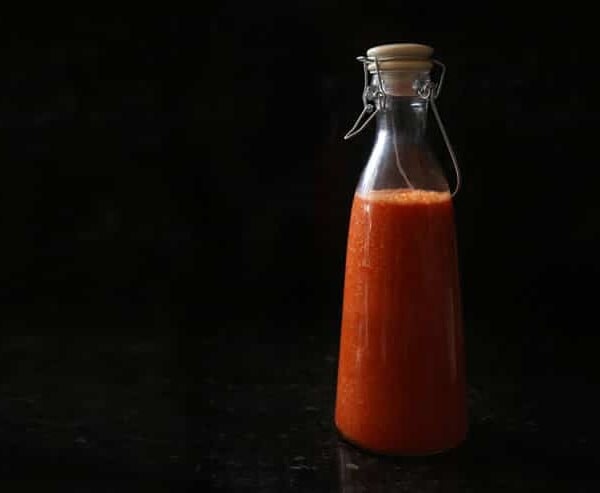

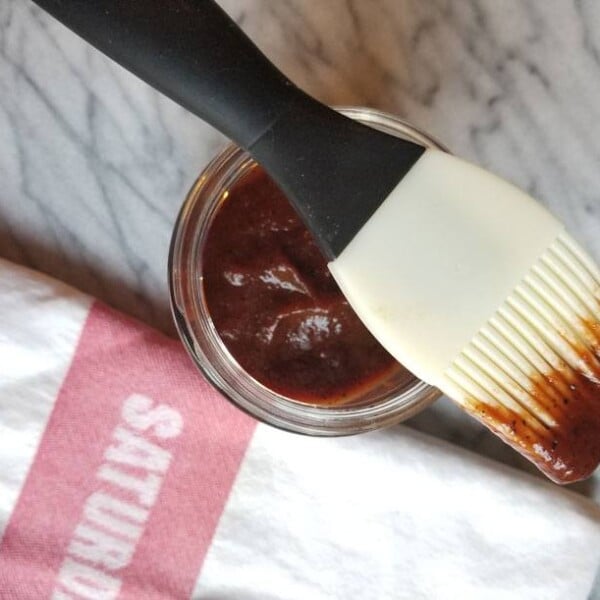
















love your boots your so beautiful. ne i used a fresnale lens to melt water and keep the salt now have a solar cooker for that.
We’ve been harvesting salt in Cape Town, South Africa for a couple of years now. We have a perfect Mediterranean climate which allows the formation of a perfect salt crust in the rock pools between the high tide cycles in summer (as long as it doesn’t rain). We have recently made a solar oven using a black plastic bucket, collect fresh sea water and evaporate it. Within a sunny week, we can harvest enough salt for our personal use. That’s only when the source on the rocks is unavailable!
Sue, I like your idea that you are using in Cape Town. Would you please e-mail me (ruichardbash@bashlaw.com) your solar oven design so I might try your method? Many thanks.
Cool post. Thanks! To the folks w advanced degrees, I too have an advanced degree and lots o experience in the physical sciences. As I dabble in cooking, one thing that comes up over and over is that these systems are complex and that the correct scientific explanation comes after the cooking method, not before. I agree that for a simple system of pure NaCl and water, whether or not the temp goes about 170 is irrelevant. But sea water is much more complex. Which is prob the best argument for making your own salt (although Harold McGee claims that the different tastes of sea salts comes from the shape of the crystals and how they make contact with the tongue, not the impurities). I too am concerned about pollutants. Then again, I am not sure if the store bought sea salts are all that pure. I suspect that the… Read more »
I can’t wait to try this. If you don’t mind revealing your location, what beach do you harvest from? I am also interested in seaweed harvisting, but don’t know what beach would be considered clean enough to harvest from within a reasobable distance from Seattle. Also, how did you figure that the beach you harvest from is clean? Thanks for the post! Btw, your “DINK’s” comment made me laugh!
I love it! I stare at the ocean all day, I might as well put it to use!
I collect sand from beaches (like 2 T)….never occurred to me to collect sea-water & make my own salt! What a great idea!
Have you tried Himalayan pink salt from Sustainable Sourcing? Here’s their website where I get my salt: https://secure.sustainablesourcing.com
How much salt comes out of an ice chest of sea water?
Okay. Now I MUST try this for myself. You make it sound so accessible. Thank you!
I’ve come to believe that my life won’t be complete until I’ve gone on a sea water harvesting adventure with you Linda. Seriously, this post is so fun and inspiring!
Chem-wise, “salt” does not exist in water that is not saturated; only the ions exist in solution. Boiling changes the rate at which water is removed, which is another way of saying that it changes the time to saturation (and crystallization). So perhaps removing the water “too quickly” has something to do with salt crystal formation. I’m not sure why one cares how it forms as long as salt crystals are obtained, but that’s rather irrelevant. A rare but completely viable option is to forgo the settling period and use vacuum filtration with <0.22um filters. But then, I suppose most people are not graduate students in water treatment 😉 Thanks for the tip! I brought ~5gal of seawater home from the FL panhandle because I can't justify going to the beach without collecting water… I've been waiting for "something to do" with it, so I may try this with ~1gal… Read more »